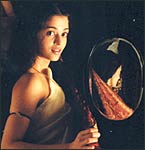Home > Movies > Features
The Bollywood renaissance
Dinesh Raheja and Jitendra Kothari |
May 27, 2004 20:01 IST
 Former Movie magazine editor Dinesh Raheja and deputy editor Jitendra Kothari recently released their book, Indian Cinema: The Bollywood Saga. The following is an excerpt from the book:
Former Movie magazine editor Dinesh Raheja and deputy editor Jitendra Kothari recently released their book, Indian Cinema: The Bollywood Saga. The following is an excerpt from the book:
Amidst the many millennial changes, star power continued to be the pivot. The first month of the first year of the new millennium hoisted a neophyte actor Hrithik Roshan to superstardom when his debut film Kaho Naa... Pyaar Hai hit the box office jackpot in January 2000. Hrithik's 'knee-buckling Elvis Presley good looks' (senior actress Rekha's description), his cartilage-defying dance moves, and his ability to project an endearing earnestness unleashed an unprecedented hysteria amongst young fans.
A questionable choice of films thereafter threatened to eclipse Hrithik's starlight, but his filmmaker father Rakesh Roshan has deftly orchestrated his return to the centre stage with Koi... Mil Gaya. Playing an autistic Simple Simon whose close encounters with an alien lead to the flowering of his inner strength, Hrithik etched a piquant portrait of innocence under siege.
 | More on Rediff: |  | |
|
Yet, even in this age of Hrithik-happy adolescents, Amitabh successfully fended off obsolescence, though his age crossed the retirement Rubicon of 58 years in 2000. After his comeback stumble in the late '90s, many had declared him close to retirement and he had been virtually written off after he suffered colossal losses in his production company, ABCL. His resurrection to superstardom was sue to the phenomenal success of a TV quiz show, Kaun Banega Crorepati. In no time, he was back on the top of film popularity charts with Mohabbatein and Kabhi Khushi Kabhie Gham.
Shah Rukh may have hit a speed bump when his own production Phir Bhi Dil Hai Hindustani failed to make it to the winner's post at around the same time when Kaho Naa... Pyaar Hai was storming the theatres. However, with Mohabbatein, Kabhi Khushi Kabhie Gham, Devdas, and Kal Ho Naa Ho the actor reaffirmed that he was the most bankable star.
The triumph of Lagaan put Aamir Khan in an exclusive league of his own. Sunny Deol's blockbuster Gadar and a string of good performances from Ajay Devgan (The Legend of Bhagat Singh, Company, Gangaajal) ensured their enduring prominence even as the spotlight shone brightly on charismatic newcomers like Vivek Oberoi. Aishwarya Rai and Kareena Kapoor were in the vanguard amongst the heroines after Devdas and Mujhe Kucch Kehna Hai.
 Aishwarya and Kareena have opted to work with a clutch of non-mainstream names. Aishwarya has worked with Rituparno Ghosh in Chokher Bali, Gurinder Chadha in Bride And Prejudice, and is expected to join forces with Deepa Mehta in Sahib Biwi Aur Ghulam. Kareena is currently acting opposite the likes of Rahul Bose and Rahul Khanna and is excited about working with her new set of directors – respected names in offbeat cinema such as Mani Ratnam, Govind Nihalani, Rituparno Ghosh, and Deepa Mehta. Propelled by the belief that it is the novel that appeals, the desire to do something different has obviously entered the mainstream.
Aishwarya and Kareena have opted to work with a clutch of non-mainstream names. Aishwarya has worked with Rituparno Ghosh in Chokher Bali, Gurinder Chadha in Bride And Prejudice, and is expected to join forces with Deepa Mehta in Sahib Biwi Aur Ghulam. Kareena is currently acting opposite the likes of Rahul Bose and Rahul Khanna and is excited about working with her new set of directors – respected names in offbeat cinema such as Mani Ratnam, Govind Nihalani, Rituparno Ghosh, and Deepa Mehta. Propelled by the belief that it is the novel that appeals, the desire to do something different has obviously entered the mainstream.
This latest shift in Hindi cinema reflects its inherent nature. For all its seeming homogeneity, it is constantly evolving, morphing and mutating. And the saga of Hindi films remains, as ever, endlessly fascinating.
Printed with permission from the author. Indian Cinema: The Bollywood Saga, by Dinesh Raheja and Jitendra Kothari. Published by Roli Books, Rs 1,975. Pages 155